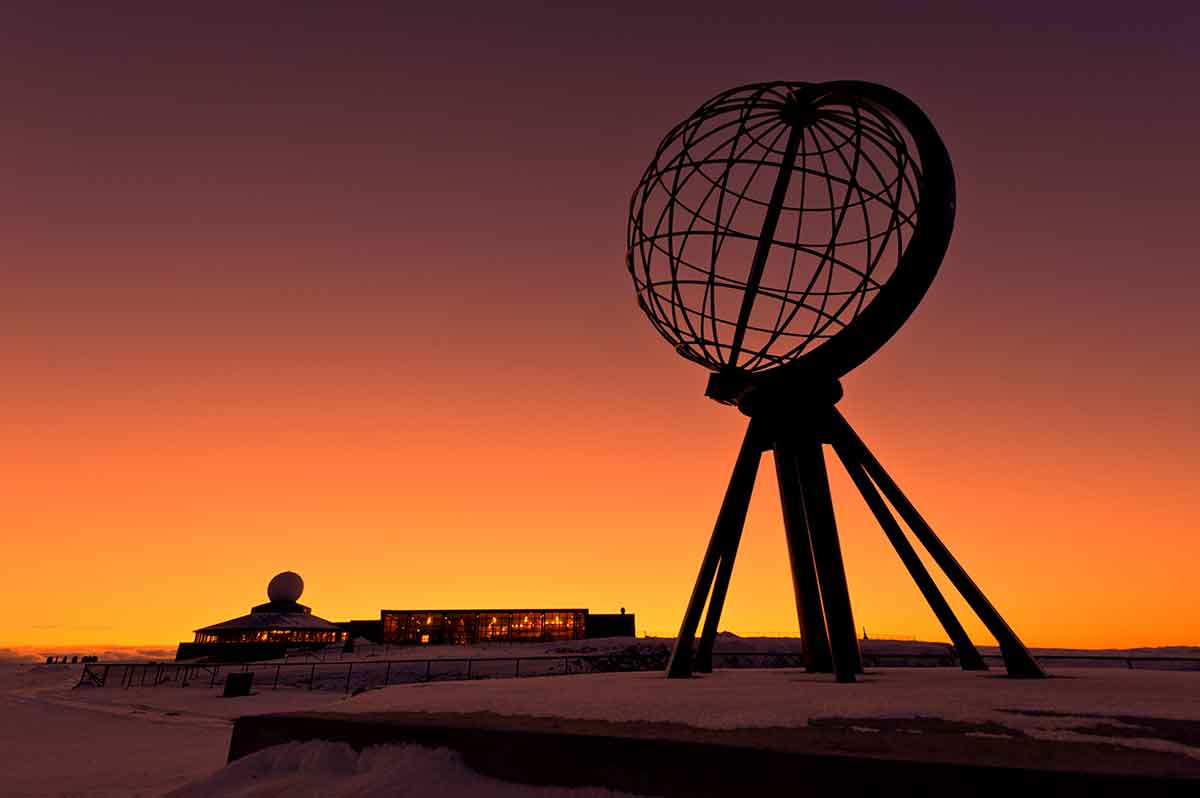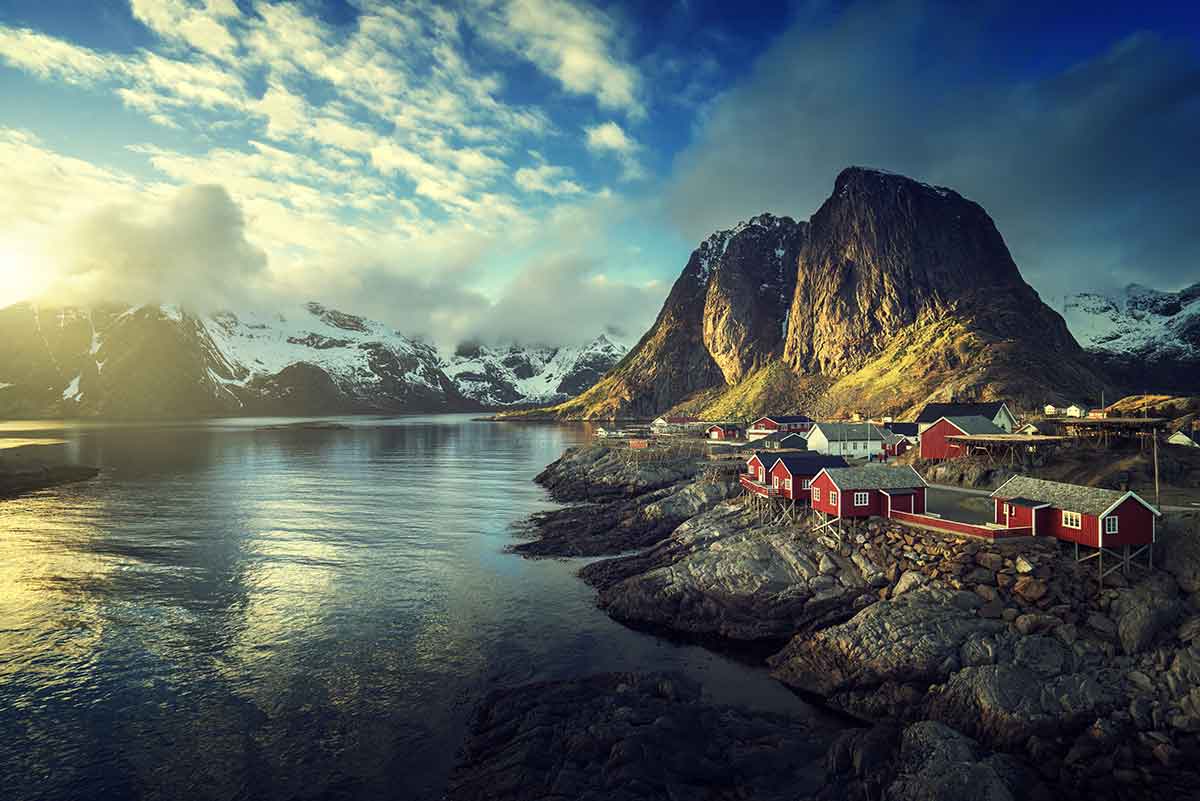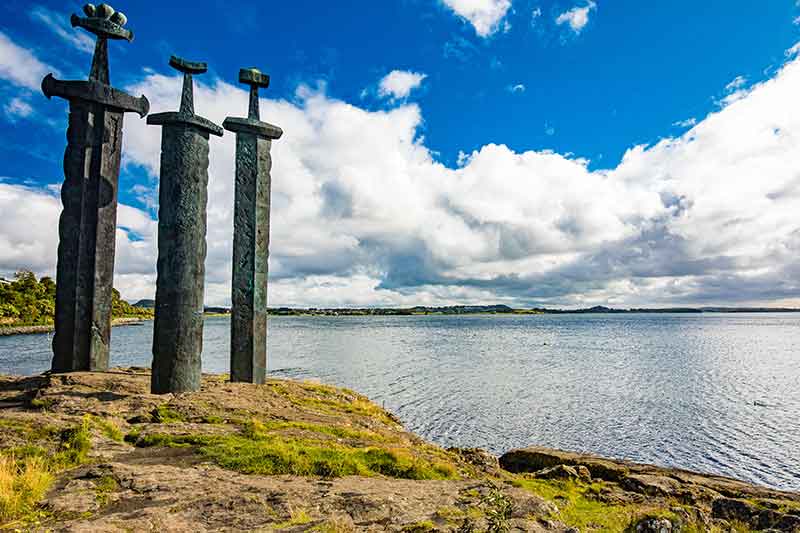A kingdom in Scandinavia stretching up into the Arctic circle, Norway is a truly magical country to visit. Known for its stunningly scenic fjords, other famous landmarks in Norway include the Nobel Peace Centre, the most remote island in the world and a curiously-named village called Hell. And thanks to Norway, Japan has a fresh salmon supply introduced to Japanese cooking for sushi and sashimi in the 1980s.
Europe’s largest herd of wild reindeer roams Norway’s Hardangervidda, a gigantic mountain plateau. Known to rest of the world as Norway, the land is called Norge or Noreg by natives. Norway has a rich history dotted with myths and legends, present in historical and natural landmarks in Norway. Here are the 20 most famous landmarks of Norway you need to put on your travel wish list.
20 Landmarks In Norway
Natural Landmarks In Norway
1- North Cape

The North Cape is the northernmost point of Europe. Known as Nordkapp, the North Cape is in Western Finnmark, where the Atlantic and Arctic Oceans meet.
Tourists have been visiting North Cape since 1664 when Francesco Negri, an Italian priest, visited.
During the summer North Cape sees a midnight sun, as the sun does not set between May and July.
North Cape is a popular place for winter sports, including ice fishing, snowshoeing and skiing.
Head to the 307m (1007ft) above sea level cliff plateau for incredible views over the cape, and of course photographic opportunities.
North Cape is at 9764 Nordkapp.
2- Preikestolen (Pulpit Rock)

Preikestolen is one of the most scenic locations in Norway. Translated as Pulpit Rock, Preikestolen sits high above the fjord below.
The cliff was formed over 10,000 years ago and is 604m (1982ft) above the water’s surface.
Preikestolen is one of the most famous and most photographed locations in Norway, as tourists embark on the four to five-hour hike to reach the top of the cliff, before some brave a seat on the edge for an exhilarating selfie.
Preikestolen is at 4129 Songesand.
3- Trolltunga

Another spectacular rock formation high above a fjord is Trolltunga, which reaches across Ringedalsvatnet Lake.
Trolltunga is on the western edge of the Hardangervidda plateau.
The rock formation was carved from the ice cap that covered most of Scandinavia thousands of years ago.
Jutting out 700m(2300ft) above the water, Trolltunga resembles a tongue, and a legend gives the rock its name.
Norse legend tells of a troll who had a taste for dangerous adventures such as diving into deep waters and jumping over canyons.
One day he decided to see if the stories that the sun turned trolls to rock were true.
Sitting in a cave, he stuck out his tongue and waited for the sun to rise and unfortunately, the troll turned into stone.
Trolltunga is at 5760 Røldal.
4- Lofoten Islands

Above the Arctic Circle lie the Lofoten Islands dotted across the Norwegian Sea.
The islands’ landscape is incredibly diverse, and thanks to ongoing projects as part of the islands Sustainable Destination certification, visitors can explore the islands’ nature, culture, and environment.
Lofoten Islands are one of the best surfing locations in Norway, and they hold the title of the worlds northernmost site for surfing.
The largest Viking longhouse ever found was uncovered in Borg, and has now been transformed into a museum.
Visitors have the opportunity to go hiking, skiing and ocean rafting here, and if visiting between May and July, a chance to see the midnight sun.
Lofoten Islands is at 8314 Gimsøysand.
5- Kjeragbolten

Wedged in a Kjerag mountain crevasse, Kjeragbolten is a large boulder and a famous tourist destination.
The boulder is a large glacial deposit wedged 1084m (3556ft) above Lysefjorden.
The rock is popular with tourists, as no specialist equipment is needed to reach the rock and many flock to Kerang mountain to have an unusual photograph taken.
The rock is also a dream location for base jumpers.
Kjeragbolten is at 4127 Lysebotn.
For more amazing European Landmarks, read:
- 30 Spain Landmarks
- 20 Switzerland Landmarks
- 22 Germany Landmarks
- 35 London Landmarks
- 30 France Landmarks
- 20 Italy Landmarks
- 20 Greece Landmarks
- 20 Russia Landmarks
- 20 Scotland Landmarks
- 20 Ireland Landmarks
- 21 Wales Landmarks
- 20 Turkey Landmarks
- 20 England Landmarks
- 20 Hungary Landmarks
- 21 Romania Landmarks
- 20 Ukraine Landmarks
- 20 Athens Landmarks
- 20 Rome Landmarks
- 20 England Landmarks
- 20 Portugal Landmarks
- 20 Poland Landmarks
- 20 Iceland Landmarks
- 20 Bulgaria Landmarks
- 21 Croatia Landmarks
- 20 Bulgaria Landmarks
- 20 Austria Landmarks
- 21 Finland Landmarks
- 20 Sweden Landmarks
- 20 Denmark Landmarks
- 20 Belgium Landmarks
- 20 Netherlands Landmarks
- 20 Barcelona Landmarks
- 21 Czech Republic Landmarks
- 20 Landmarks in Paris
- 20 Landmarks in Liverpool
- 10 Istanbul Landmarks
6- Sognefjord
Sognefjord is the largest and deepest fjord in Norway.
Nicknamed ‘the King of the Fjords’, Sognefjord is 126 miles (204 km) long and stretches from the ocean before ending at a small village named Skjolden.
The fjord is 1308m (4291ft) at its deepest and was described by UNESCO as ‘among the most scenically outstanding anywhere’, gaining the fjord a place on the UNESCO World Heritage List.
The shores of the fjord are scattered with picturesque villages.
Visit book towns Fjærland and Tvedestrand where second-hand bookstores, festivals, and other literary events lure tourists away from the fjord’s tranquil blue waters.
Sognefjord is at Vestland.
7- Voringfossen Waterfall

Voringfossen Waterfall is one of the most spectacular natural landmarks in Norway.
The waterfall is 182m (597ft) high, fed from the Hardangervidda plateau and cascades into the Måbødalen valley.
Many pleasant walks within the Måbødalen valley incorporate the falls, and Fjord tours also take tourists to the falls as part of their package.
In August 2020 the bridge over the falls opened, allowing visitors a closer look at the falls.
It has viewing and lookout points of both the falls and the valley.
Voringfossen is at 5785 Eidfjord.
8- Svalbard

An indescribable Arctic landscape of three seasons (polar summer, Northern Lights winter, sunny winter), Svalbard is Norway’s gateway to the North Pole.
The natural landscape of the islands of Svalbard features vast tundra, glaciers and bare mountains.
During the polar summer, the sun shines for 24 hours a day, and in winter where the sky is completely dark, the Northern Lights are both frequently seen and breathtaking each time.
Svalbard is a popular spot for Arctic expeditions, riding a sled pulled by dogs, or looking for polar bears on an Arctic boat ride.
Svalbard is a group of islands north of Norway. Flights from Oslo and Tromsø are the best way to reach the islands.
Also read: Best Time To Visit Iceland.
9- Nigardsbreen Glacier
Nigardsbreen Glacier is one of the most beautiful and accessible glaciers in Norway.
The glacier has a low altitude of 300m (1000ft), making it an easy-to-reach hikers’ location on guided walks.
The glacier ice is blue beneath the snow, giving the area a more arctic than mainland feel.
Nigardsbreen Glacier has been immortalised by some of Norway’s most famous national-romantic era artists and it is easy to see why they were drawn to this fascinating landscape.
Nigardsbreen Glacier is at 6871 Jostedal.
10- Lovatnet Lake
Lovatnet Lake has emerald green waters caused by the glacial meltwater from Jostedals glacier that feeds the lake.
The lake covers 10.4 square kilometres (6 square miles) and is 11 kilometres long (6 miles).
In 1905 and 1936, a landslide into the lake caused two tsunamis that covered a whole village.
Due to these disasters, the village is deserted.
A memorial to those who lost their lives stands in the area.
Forested mountains surround the lake, waterfalls rushing down rock faces, and perfectly picturesque camping spots.
Lovatnet Lake is at 6789 Loen.
Also read:
Historical Landmarks of Norway
11- The Swords of Stavanger

Sverd i fjell, or swords in rock, are an unusual landmark to visit in Norway.
The swords are 10m (33ft) tall and stand tall in the ground below a hill next to Hafrsfjord.
They are a Norwegian monument to the Battle of Hafrsfjord which took place in 872.
The battle allowed King Harald to reunite the entirety of Norway under his rule.
Fritz Røed made the swords cast from bronze and were unveiled by King Olav in 1983.
The Swords of Stavanger is at Møllebukta, 4044 Hafrsfjord.
12- Bryggen

Built after the great fire of 1702 and now on the UNESCO World Heritage List, Bryggen is an important cultural location in Bergen.
Bryggen is a row of Hanseatic heritage commercial buildings that line the harbour and are Norway’s most visited tourist attraction.
The buildings are made of wood and built closely together, sharing backyard spaces and creating a community atmosphere.
Today, Bryggen consists of 61 preserved buildings and museums focusing on the area’s maritime and shipping history.
Bryggen is also the starting point for cruises to three of Norway’s famous fjords.
Bryggen is at 5003 Bergen.
13- Vigeland Sculpture Park
Vigeland Sculpture Park has over 200 of sculptor Gustav Vigeland’s works.
The sculptures are made from wrought iron, bronze and granite and are the result of 40 years of the sculptor’s work.
The most famous sculptures within the park include The Monolith and The Wheel of Life.
Vigeland also designed the layout of the park, with visitors welcomed to the park by a fountain.
Vigeland Sculpture Park is at Nobels gate 32, south of Vigeland Park, Frogner.
14- Akershus Fortress

Under the command of King Håkon V, Akershus Castle and Fortress was completed in the 1300s.
The fortress is at the headland, giving it a strategic advantage over attackers.
So it’s not surprising that throughout its history, the fortress has withstood many sieges.
During King Christian IV’s reign, the fortress was transformed into a Renaissance castle for the royal family to live.
Akershus Fortress is at Festningsplassen 1, 0015 Oslo.
15- Urnes Stavkyrkje
Urnes Stavkyrkje is Norway’s oldest stave church.
The church dates from 1130 and incorporates three previous churches materials that existed in the 100 years before Urnes was built.
The church has a dark brown, almost black in places exterior which is a pleasing contrast to the lush green forests surrounding it, and the blue hue of the fjord below.
Within the church are many points of interest including 12th-century figures featuring Jesus on the cross, a ciborium altar from 1699 and a large section of highly decorated wall from the third church incorporated on the north-side.
The church joined the UNESCO World Heritage List in 1979.
Urnes Stavkyrkje is at 6870 Ornes.
16- Nidaros Cathedral
Nidaros Cathedral is the national sanctuary of Norway sits over the grave of St Olav.
Construction began in 1070 and the cathedral was completed in 1300 but was in ruins after a fire in 1537.
During the 1800s there were extensive renovations to the cathedra that left parts of the cathedral standing from the 12th century.
The stained glass within the cathedral is more modern, and was completed and fitted during the early 20th century.
King Olav Haraldsson is buried underneath what is now the high altar.
Nidaros Cathedral is at Kongsgårdsgata 2, 7013 Trondheim.
17- Viking Ship Museum
The Viking Ship Museum is home to the worlds best-preserved Viking ships.
There are three ships within the museum; Gokstad, Tune and Oseberg, all of which were sea-going ships.
The ships were all used in funeral rituals and were unearthed surrounded by riches and treasures.
Within the museum are skeletal remains from the burials and the treasures found with the boats.
A new ship, Gjellestad, is currently being excavated and will be placed in the museum once it has been studied.
The Viking Ship Museum is at Huk Aveny 35, 0287 Oslo.
18- Tromsø
Tromsø is the gateway to the Arctic, and the northernmost city in the land is a landmark in Norway’s landscape.
One of the most famous reasons for visiting Tromsø is for the Northern Lights, as the chances of seeing them are much higher than anywhere else in Norway.
Tromsø is also a popular starting location for exploratory trips to the Arctic and the North Pole from Europe, as explorers and scientists acclimatise and prepare for their stay on the ice.
Tromsø is in northern Norway.
19- The Atlantic Road
The Atlantic Road is one of the best driving roads in Norway, and indeed the world. It follows the coastal edge of Norway and crosses several small islands.
The five miles (8.3 kilometres) long road has eight bridges, many roads built directly on the islands and views from either side across the sea.
Not only does the route take in spectacular natural landscapes, but also a wide variety of local wildlife.
The Atlantic Road was awarded the Norwegian Construction of the Century in 2005.
The Atlantic Road is between the cities of Molde and Kristiansund.
20- Nobel Peace Centre
The Nobel Peace Centre is in Oslo and is home to the Nobel Peace Prize.
British architect David Adjaye and American designer David Small collaborated to transform the old train station building, built in 1872, into the Peace Centre.
The Nobel Peace Centre is close to the centre of Oslo and offers spectacular views over the harbour.
Within the centre are regular exhibitions, talks and tours. Every Friday a peace dove is released from the Peace Centre.
Nobel Peace centre is at Brynjulf Bulls Plass 1, City Hall Square, 0250 Oslo.
- 20 Incredible Landmarks in Norway
- 20 Fairytale Castles In Norway
- Cruising The Norwegian Fjords
- 17 Things To Do In Tromso
- When Is The Best Time To Visit Norway?
- 20 Norwegian Cities


Plan Your Trip

Rent A Car – Find the best car rental rates at Discover Cars. They compare car hire companies to provide you with the best deal right now.

Find A Hotel – If you’re curious about this article and are looking for somewhere to stay, take a look at these amazing hotels.

